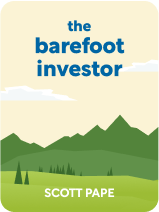

This article is an excerpt from the Shortform book guide to "The Barefoot Investor" by Scott Pape. Shortform has the world's best summaries and analyses of books you should be reading.
Like this article? Sign up for a free trial here .
Do you want to apply the lessons from The Barefoot Investor? What are some The Barefoot Investor tips for personal finance management?
In The Barefoot Investor, Scott Pape offers practical tips to manage your money so that you can eliminate debt and start building wealth. The was written for an Australian audience, but the following The Barefoot Investor tips are universally applicable.
Here are five personal finance management tips from The Barefoot Investor.
The Barefoot Investor: 5 Tips for Personal Money Management
Many people feel helpless when it comes to managing their money. They’re consumed by debt or worry that they’ll never be financially secure. Here are five tips from The Barefoot Investor to get you started on your barefoot journey.
Tip 1: Switch to a Low-Cost Bank
Many people bank with a high-cost bank without realizing it—for instance, they might have an account at the same place that their parents did, or they might have received a bank account with their home loan. But there’s good reason to switch: Switching to banks with no fees can save you thousands of dollars over the course of your lifetime.
In The Barefoot Investor, Scott Pape recommends setting up five bank accounts: two checking accounts, two savings accounts, and a backstop account.
Tip 2: Scrutinize Your Insurance Options
Life comes with losses, such as losing a job or becoming disabled. Having insurance helps protect you from the financial costs of these losses. However, finding appropriate insurance can be tricky. Here are some common insurance pitfalls:
- We pay for coverage we don’t need.
- We pay too much for insurance.
- We fail to get the coverage we do need.
The Barefoot Investor gives these two pieces of advice to follow when choosing and managing insurance:
- If losing it won’t affect your financial situation, don’t insure it. For example, if you damage your phone beyond repair, you’ll be able to get a new one without putting yourself at a financial disadvantage, so don’t insure it. On the other hand, if your house burns down, you’ll want to recoup the value of the house itself and the possessions within. Here are some other common items or scenarios to consider insuring against:
- Losing the ability to work, or becoming disabled
- Death
- Theft
- Car accidents
- Health insurance (more on this below)
- Becoming ill and needing medical care while traveling abroad
- Negotiate your annual insurance premiums down. Companies want to retain your business. If you call them and tell them you’re thinking about switching, they’ll likely be willing to negotiate a better deal for you. You can also offer to pay more money, or excess, which is the initial amount of money you’re willing to pay toward a claim. By increasing the amount of excess you’re willing to pay, you can decrease your insurance cost. Since you now have a Backstop account, you’ll have the extra money to pay if something catastrophic happens.
Tip 3: Pay off Your Debt
Having debt can take an emotional toll. You might feel as though you’ll never be good with money, and climbing out of debt can feel impossible. To rebuild your self-esteem and financial security, Pape advocates paying off your debts and getting rid of your credit cards.
Follow these steps to pay off your debts one by one:
1. List your debts. Use a table like this one to list your debts from smallest to greatest.
| Debt | Total | Interest Rate | Minimum Monthly Payment |
| Total: |
2. Renegotiate your interest rates. Tell your bank that you’re considering transferring your credit balance to another bank that will charge you no fees for 18 months. Ask them to renegotiate your interest rate and waive your annual fee. This is the best course of action for most people because it helps you avoid spending on a new card. However, if you really can pay down this debt in 18 months, and avoid spending on a new card, consider switching to a bank with this type of transfer program.
3. Get rid of your credit cards. Cut them up and post a photo on Barefoot Investor’s Facebook page.
4. Pay off your debts one at a time, starting with the smallest. Use the money from your Fire account to pay off this debt as quickly as possible, while making the minimum payments on your other debts. Though you won’t likely pay off the debt with the highest interest rate first, once you’ve paid off one debt, you’ll gain confidence and feel motivated to pay off the others.
5. When you pay off a debt, celebrate. Pape suggests burning your credit card bills with a lighter. Apply the amount you were paying on the now paid-off debt toward paying down your next-highest debt.
6. Repeat until you’ve paid off all of your debts.
Tip 4: Pay off Your Mortgage Early
Due to interest payments, you’ll pay more than the cost of your home over the lifetime of your loan. To limit how much interest you pay over the life of your mortgage, work to pay it off faster. Besides saving on interest, you’ll be able to direct the money that was going toward your mortgage elsewhere.
The first step is ensuring you don’t get sucked into constantly upgrading your home and remaining perpetually in debt.
Avoid the Desire for Another House
Many people yearn to buy things that they think will bring them great enjoyment. When people do this with houses, no house is ever good enough. People may buy one house, and then buy and move to another, and then another, thinking that they’ll land in the perfect home and perfect neighborhood someday. They may take on more debt than they can afford, which can cause stress because money becomes tight and they have to carefully consider every spending opportunity. They may think this is simply the reality of homeownership and wealth-building.
But this isn’t everyone’s reality. People who successfully build wealth tend to save money, invest in the share market, avoid buying things they can’t afford, and live in modest neighborhoods rather than affluent suburbs. Instead of constantly pining for the next thing and taking on debts you can’t afford, following the steps in this book will position you to buy a home within your means and, ideally, feel satisfied enough to stay there instead of chasing the next best thing.
Follow these two steps to pay off your mortgage faster:
- Call your bank and negotiate a lower rate. Tell the bank that you’re planning to switch to another bank with a lower interest rate unless they give you a 0.5 percent discount. If it doesn’t work, try calling them back a few times. However, this step is best attempted when you already own 20 percent of your home.
- Direct the money from your Fire account toward your home loan. You’ll now use the funds from this account to put extra payments toward your mortgage. Use a calculator like the ASIC MoneySmart Mortgage Calculator to calculate how long it’ll take you to pay off your mortgage using the extra payments from your Fire account. People are often able to pay their mortgages off seven years early.
Tip 5: Choose Financial Advisors Specific to Your Needs
The Barefoot Investor advises against using a personal financial planner. Financial planners generally skim a fixed percent of your assets, no matter how much money you have. This is unfair because you’re being charged more for the same service as someone with less in assets.
If you need financial advice, look to lower-cost options based on your specific needs. Here are some common options:
- Reduce your debt by working with a nonprofit financial counselor or by calling the Australian National Debt Helpline, 1-800-007-007.
- Plan for your retirement by calling your super fund and working with one of their financial counselors. After the first appointment, you’ll be charged by the hour rather than an annual fee.
- Explore long-term care with Centrelink. Their advisors can help you understand how much it will cost and how it might affect your pension.

———End of Preview———
Like what you just read? Read the rest of the world's best book summary and analysis of Scott Pape's "The Barefoot Investor" at Shortform .
Here's what you'll find in our full The Barefoot Investor summary :
- A 10-step plan to eliminate debt and build wealth
- How you can increase your income
- Why you need to focus on cultivating long-term investments






